INTRODUCTION
Color has tremendous influence on our preference of food and beverages. How a product looks impacts the consumer’s purchase and even influences how food and beverages are perceived through taste. In recent years, food colorants have come under increasing global attention for their possible health effects from allergies, aluminium content and potential behavioral problems in children. In addition to synthetic colors, carmine despite being a natural colorant has also been under increased scrutiny. As a result, food manufactures are reformulating recipes and incorporating ingredients which will enable products to display “cleaner labels”.1
The growth of natural colors increased 29% between 2007 and 2011. In contrast the growth rate for synthetics was only 4%. Of the global colors share, natural colors increased from 34% in 2007 to 39% in 2011. The segment is now worth an estimated USD $570 million.2 Kalsec® has broadened its red color product portfolio for manufacturers who would like to switch to naturally-sourced colors. This study focuses on Kalsec®Vegetone® Vivid Red high stability colors formulated for a wide range of pH conditions. The primary natural sources of these new red colors are tomato and beet.
Limitations of Certain Red Colors
Research from Innova Market Insights indicates that red is the most challenging of colors to naturally produce.3 Even then, it comprises around 50% of natural colors market demand.4 Anthocyanins can provide a bright red to bluish-red hue and are a good replacement for synthetic dyes; however, anthocyanins are unstable at pH >4.5. At this relatively higher pH, these pigments change from red to blue, are not stable and are rendered ineffective in low acid products. Carmine is another alternative but is derived from the cochineal insect and is not Kosher-approved. There are numerous consumer acceptability issues with carmine. Carmine is an aluminum salt of carminic acid, and the aluminum required to produce the carmine is a regulatory concern in some countries. Additionally, the extract can contain proteins which can cause severe allergic reactions in humans. Moreover, a FDA rule effective January 5, 2011 requires all foods containing cochineal to declare the ingredient on consumer food labels. Also, as of August 2014 the use of aluminum containing colors such as Carmine (E120) has been prohibited in certain foodstuffs within the EU.5 As a result, there remains a gap in naturally-sourced, consumer-friendly, stable red colorants that can be filled with Kalsec®Vegetone® Red colors. The prices for Red 40, a common synthetic colorant, have increased giving processors another reason to switch to their natural counterparts.6
Red beet and lycopene fall under the exempt category in the US Code of Federal Regulations (CFR) and are approved for use in food as food additives. Kalsec®Vegetone® Red colors are stable at a wide pH range, when compared to anthocyanins, and provide more consumer-friendly attributes than carmine since they are derived from vegetable sources and are Kosher approved.
Red Beet: Betalains
Red beet (Beta vulgaris L.) is a root crop that grows naturally in both tropical and temperate regions and is globally consumed in cooked or raw form. Red beet color is obtained by pressing, concentrating and subjecting the juice of beetroots to heat processing.7
Structurally, betalains are immonium derivatives of betalamic acid and are categorized into either betacyanins or betaxanthins. Condensation products of betalamic acid and cyclo-Dopa [cyclo- 3-(3, 4-dihydroxyphenylalanine)] are commonly referred to as betacyanins due to their deep violet color. The maximum absorption of these compounds varies between 510-550 nm. Betanin is the major betacyanin present in red beet. Betaxanthins (yellow) are condensation products of betalamic acid and amino acids or amines, respectively. Depending on the particular structure of the amino compound, maximum absorption of betaxanthins varies between 460 and 480 nm.7
Though relatively robust with respect to pH changes, betalains perform their best in the pH range 3-7. They are sensitive to intense heat processing including Ultra-high temperature (UHT). They perform better in lower water activity conditions and certain stabilizers, including chelating agents, improve their stability. They are prone to degradation under oxygen and are best preserved by excluding air. They also perform better at high pigment concentrations.8
Red beet and lycopene fall under the exempt category in the US Code of Federal Regulations (CFR) and are approved for use in food as food additives. Kalsec®Vegetone® Red colors are stable at a wide pH range, when compared to anthocyanins, and provide more consumer-friendly attributes than carmine since they are derived from vegetable sources and are Kosher-approved.
Lycopene
Lycopene is a member of the carotenoid family and is responsible for the characteristic red color of tomato, watermelon, pink grapefruit, orange and apricot. Lycopene has 11 conjugated double bonds and 2 unconjugated double bonds at each end.9 Kalsec®Vegetone® Vivid Red lycopene colors are extracted from tomatoes, a source allowed by FDA standards. Lycopene is a hydrophobic molecule and is not soluble in water. Lycopene’s solubility in vegetable oil is 0.2 g/L at room temperature which increases upon heating.10 Lycopene tends to aggregate into crystals in aqueous systems. This behavior, however, can be exploited and particle size can be reduced to form dispersion in aqueous foods. This enables the color expression to be red instead of the yellowish-orange which would occur if it were to be dissolved in a fat-based medium or on heating. Vegetone® Rich Red lycopene colors perform well for water-based applications. In the presence of higher amounts of oil and heat these pigments will dissolve and impart an orange color to a finished food.
Lycopene is heat stable and functions well in retorting and extrusion; with only limited pigment loss during processing. Like other carotenoids, lycopene is sensitive to light; therefore products should be protected with appropriate packaging.9
EXPERIMENTAL
Kalsec®Vegetone® Vivid Red beet color -57.01 was obtained in house. ‘Control’ was prepared from the raw material used to make 57.01. Only raw material and water were added and mixed to make the control. It was made similarly as 57.01 was made, except that no stabilizers were added. Betanin content for both Vegetone Vivid Red and control was 0.62%. Kalsec®Vegetone®Rich Red lycopene color – 59.01 with a 1.75% lycopene was obtained in house. A Kalsec® paprika oleoresin product and a Kalsec® paprika emulsion products were used. Both of these were formulated in house.
METHODS
Preparation of hard candy: Light corn syrup was obtained from Meijer Store (Grand Rapids, MI, USA). Granulated sugar was obtained from Gordon Food Service (Wyoming, MI, USA). 30% corn syrup, 14% water and 56% sugar were weighed and mixed in a beaker. The beaker was covered with a watch glass and heated until contents dissolved. After that watch glass was removed and temperature monitored. Heating was continued until temperature reached 150 o C. At this time, beaker was taken off heat and 57.01 were added at 0.2%. This mixture was then mixed thoroughly and poured onto a heat resistant mat and allowed to solidify. Candy was similarly prepared using control. Color at 0.2% was added as soon as beaker was taken off hot plate.
Plating on flour salt: Alberger Fine Prepared Flour salt was obtained from Zeeland (Cargill Foods). Retsch RM 200 mortar grinder mill was used for plating. The flour salt and colors -Vegetone® Vivid Red beet color or control were added at 0.2% and plated for 4 minutes. 100 g colored flour salt was dispensed into a 4-ounce glass jars to observe the color expression.
To compare lycopene with another color, another carotenoid, paprika was chosen. A paprika oleoresin product of 3150 American Spice Trade Association (ASTA) value was used and was added to flour salt at 1%. Plating was carried out using Retsch RM 200 mortar grinder mill. Plating was carried out for 4 min. Lycopene content was matched spectrophotometrically to paprika at respective absorbance maxima, 3.4% of Vegetone® Rich Red lycopene color was added to flour salt and processed similarly as done for paprika. For analysis of lycopene and paprika in flour salt application under heat, 2 g of samples was dispensed in multiple open test tubes and incubated at 78 o C. At specified time intervals, one test tube was pulled out and analyzed spectrophotometrically. Approximately 50ml Tetrahydrofuran (THF) was added to 2 g sample in a beaker, and the solution as filtered through whatman no 1, in to a 100 ml volumetric flask. Volume was made with THF and absorbances read at 478 nm (for lycopene) and at 460 nm (for paprika). For study in light, five g samples were placed in scintillation vials and these vials were kept in ATLAS XXL. A light intensity of 50 W/m2 was used and window glass filter was used. Water was sprayed to maintain the temperature at 24 o C. These samples were analyzed similarly as the samples in heat, except here 5 g sample was used in analysis.
Preparation of beverages: pH 5.0 buffer was used to create a model beverage. 0.025% citric acid and 0.075% sodium citrate dehydrate were added to water and pH maintained at 5.0 using 1% citric acid/0.5% KOH solution. To this 8% sucrose was added and mixed. Beverages with beet were dosed at 0.114% of Vegetone Vivid Red beet or control. 10 g of solutions were poured in scintillation vials. These vials were incubated at 35 o C. Absorbances at 530 nm were measured and % absorbance retention was calculated at different time points.
Another beverage system used for this study was at lower pH (3.1). 14.3 % High Fructose Corn Syrup (HFCS) 55 (Batory Foods, IL, USA), 0.0165% sodium benzoate (Sigma, St. Louis, MO, USA) and 0.063% citric acid (Sigma, St. Louis, MO, USA) were mixed. This beverage was used for comparison of lycopene with paprika emulsion. Vegetone® Rich Red lycopene color was added at 0.035% or a paprika emulsion (ASTA value 453.75) was added at 0.072%- so as to match the color spectrophotometrically at respective absorbance maxima. The beverage was poured in 500ml HDPE bottles. Colorimetry was carried out using CM700 d (Konica Minolta) at regular intervals while incubation in light. A D65 source of illumination was used and a 10 degree observer was used. Instrument was used in SAV mode (aperture equals 3 -6 mm). This instrument has an integrating sphere of 40 mm. Specular Component Excluded (SCE) mode was used. Colorimetry was carried out non- invasively by holding colorimeter against a smooth surface of bottle while using a white background on other side of bottle. CIE 1976 L*, a* and b* values were obtained. SpectraMagic NX software was used to record the data.
Beverages containing lycopene at two doses were heat processed. pH 5.0 model beverage, formulation of which has been described above, was used for this study. To the beverage, 0.11 and 0.22% of Vegetone® Rich Red lycopene color was added. These beverages were then sealed in glass bottles and heat processed at 15 psi/ 15 min. For analysis, 2 g of beverage was weighed in a 25 ml volumetric flask and volume made up with THF. Absorbance was read at 478 nm and % absorbance retention calculated before and after processing.
Baking: A commercial white cake mix (Pillsbury, General Mills, MN, USA) was obtained and was processed according to instructions on the packaging. KalsecVegetone Vivid red beet was added at 1% to the water which was then mixed to make the cake batter. The cupcakes were baked at 350 o F for approximately 20 minutes.
Statistical Analysis: The experimental design was a completely randomized design. Type-3 tests of fixed effects were performed using the MIXED Procedure of SAS (Version 9.3, SAS Institute Inc. Cary, NC, USA). Least square means for protected F-tests (p<0.05) were separated by using the P diff option (least significant differences) and were considered significant at p><0.05.
RESULTS
Kalsec®Vegetone® Vivid Red beet stability data
Kalsec®Vegetone® Vivid Red beet color can provide increased heat processing and storage stability. Figure 1 shows the efficacy of stabilizers during the processing of hard candy. Product colored with Vegetone® Vivid Red beet color shows improved color expression (Figure 1A) whereas the control red beet colored product (no stabilizers) shows a bluer appearance (Figure 1B).
Figure 1: Color expression obtained with (A) Vegetone® Vivid Red beet color and (B) Control red beet color. The spectral component at 530 nm was found to be higher in product colored with Kalsec® red beet when measured using a colorimeter
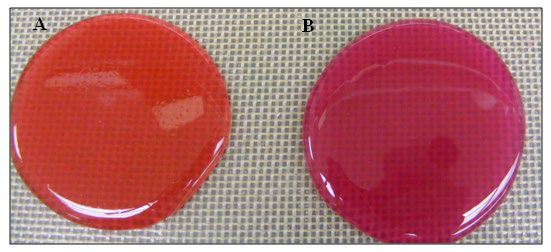
Vegetone® Vivid Red beet color provided darker color expression when plated on flour salt exhibiting a stronger red color (Figure 2A).
Figure 2: Visual comparison of beet colors on flour salt.Flour salt colored with Vegetone Vivid Red gave darker color than control when applied at the same rate.
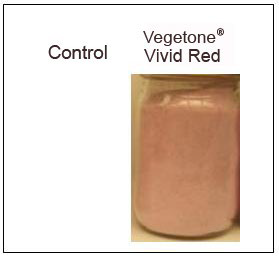
Vegetone® Vivid Red beet color and the control red beet color were added to pH 5.0 solutions and incubated at 35 o C. Vegetone® Vivid Red beet color performed better than the control red beet color during incubation as shown in Figure 3.
Figure 3: % Absorption measurement in pH 5 beverage solution under heat. The average results of two independent experiments are presented. The % absorbance of Vegetone Vivid Red was found to be significantly higher than control.
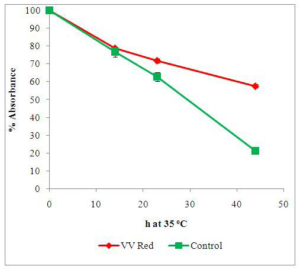
Vegetone® Vivid Red beet color was successfully used in a cupcake as shown in Figure 4.
Figure 4: Application of Vegetone® Vivid Red beet color in cupcakes.
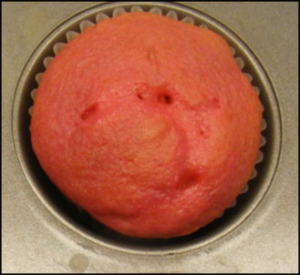
Kalsec®Vegetone®Rich Red lycopene stability data
Beverages were made from Kalsec®Vegetone® Rich Red lycopene color and stability was compared to a standard paprika emulsion coloring. The beverages were incubated at 50 W/m2 light intensity and colorimetric parameters were measured over time. The a* values were monitored and are plotted in Figure 5A. As can be seen below, Vegetone® Rich Red lycopene color was more stable through the duration of the study. The photo presented in Figure 5B demonstrates the stability of beverages with Vegetone® Rich Red lycopene color.
Figure 5: Stability of beverages colored with Vegetone® Rich Red lycopene color or a paprika emulsion in light (A) changes in a* values plotted over time and (B) visual showing beverages at zero time vs. end point. Beverages were prepared and sealed bottles were placed in an Atlas XXL instrument maintained at an intensity of 50W/m2. Instrument temperature was maintained at 25 °C. Mean results of two independent experiments are presented. The % a values were found to be significantly different between Vegetone® Vivid Red and Control.

Vegetone® Rich Red lycopene colors and standard paprika were plated onto flour salt at the same concentrations (Figure 6) and their stabilities were studied under accelerated light conditions. The color was extracted at specific time points and % absorbance at respective absorbance maxima calculated in Figure 7. As can be observed in Figure 7(A) Vegetone® Rich Red lycopene color was found to be more stable than standard paprika under light. Stability under heat conditions (78 °C) for Vegetone® Rich Red lycopene color and standard paprika were also carried out and the results are presented in Figure 7(B). Vegetone® Rich Red lycopene color outperformed paprika under these accelerated heating conditions.
Figure 6: Visual comparison of (A) paprika oleoresin and (B) Vegetone® Vivid Red lycopene and plated on flour salt.
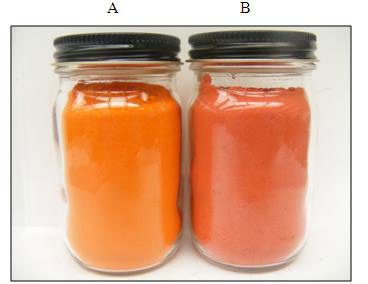
Figure 7: Stability of Vegetone®Rich Red lycopene color and paprika pigments plated onto flour salt was compared. The colors were added at the same concentration and pigment was solvent extracted from the flour salt. Percentage absorbance was calculated at respective absorbance maxima (A). Samples in scintillation vials were kept in an Atlas XXL instrument which was maintained at an intensity of 50 W/m2. The temperature of the instrument was maintained at 25°C.
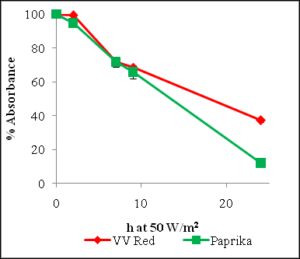
(B) Samples in open test tubes were placed in a 78°C oven and the stability was compared. Means of two independent experiments are presented. The means were found to be significantly different from each other in both heat and light.
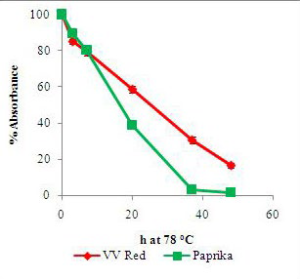
Stability of Vegetone® Rich Red lycopene color was analyzed as a result of heat processing. Vegetone® Vivid Red lycopene color was added at two doses in a pH 5.0 beverage model systems. Figure 8 shows the product before and after retorting. Table 1 indicates that the loss of pigment is dependent on concentration added. The beverage maintained almost all of the color when added at 0.22%. The beverage although lost some color when lycopene was added at lower dose, however the hue was maintained, as can be seen in the Figure 8.
Table1: Effect of retorting on Vegetone® Rich Red lycopene in a pH 5.0 beverage model system. Vegetone® Rich Red lycopene color was added at two mentioned concentrations and color was measured at 478nm using THF.
|
Concentration
|
% Retention of color after processing
|
|
0.11%
|
68.8±0.57
|
|
0.22%
|
99.8±0.65
|
Figure 8: Effect of retorting on Vegetone® Rich Red lycopene. (A) 0.11% and 0.22% lycopene before retorting (B) 0.11% and 0.22% lycopene after retorting.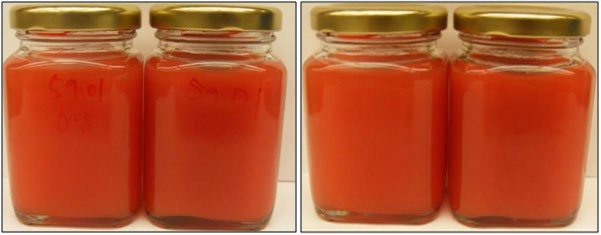
DISCUSSION
Applications based on Kalsec®Vegetone® Vivid Red beet
As observed above, Kalsec®Vegetone® Vivid Red beet gave a distinct candy product when compared to control beet product. Also, in flour salt it gave a darker product. Thus same dose of this product when put in a dry beverage mix would give a darker color than the control product. In solution form, Kalsec®Vegetone® Vivid Red beet was found to be more stable than control product. Also, it was used successfully in cupcake which is a common high pH application processed at high temperature. Use in this application demonstrates that beet can be a viable coloring option for different processed foods. Beet is generally recommended for frozen foods like ice-creams or foods for which minimal heat processing is required like chewing gum. This study demonstrates many more applications for beet. Kalsec®Vegetone® Vivid Red beet color can be used in a wide range of applications such as yogurt, ice-cream, sorbet, sausages, bakery products, frosting, hard candy and gummies. Also, it was shown to be more stable than control, which differentiates Kalsec®Vegetone® Vivid Red beet color from other products and further diversifies the domain of this product.
Kalsec®Vegetone® Vivid Red beet can be a suitable alternative to carmine for coloring sausages. Matinez et al successfully used both red beet juice and commercial betanin 162 colors in sausages and demonstrated superior performance during processing and storage. They found red beet juice to be the best performer among the colorants.11
Kalsec®Vegetone® Rich Red lycopene
As was observed with the experiments with Kalsec®Vegetone® Rich Red lycopene, the product was used in a host of applications successfully – dry (flour salt) as well as beverage. The product was found to be more stable than another carotenoid- paprika- in both flour salt and beverage application. It also survived retorting which is an otherwise harsh process. Kalsec®Vegetone® Rich Red lycopene color is used in applications where an attractive red color is desired. Examples include dairy-based applications and soy milk systems where Vegetone® Rich Red lycopene color can provide an appealing red appearance. Currently, there are no alternatives for these applications and processors have to use synthetics.
Higher stability of Vegetone® Rich Red lycopene compared to paprika, a common carotenoid used in many applications, indicates that it can easily replace paprika and perhaps synthetics colors and can still provide a viable product. Also, lycopene provides a more attractive red as against the orange hue of paprika and thus may be more appealing.
Vegetone® Rich Red lycopene works well in the replacement of carmine in sausages. Examples include mortadella, bologna and salami. Studies have been carried out on application of lycopene in sausages.12,13 The fat content of food and processing conditions are also important factors in determining Vegetone® Rich Red lycopene addition.
CONCLUSION
The Kalsec® Red Color Collection can work at various pH ranges and can provide matching hues either individually or in customized blends. Vegetone® Vivid Red beet and Rich Red lycopene colors have more stability than standard beet colors and provide improved color expression in certain applications. Vegetone® Rich Red lycopene disperses well in applications to provide an attractive and stable red appearance. Using Kalsec®’s Durabrite® stabilization technology, continuous improvements in natural pigment stability provides the food industry with suitable alternatives to certified colors throughout the world. In addition, Kalsec® has over 50 years of experience in extraction and color formulation that can address specific concerns or challenging applications.
ACKNOWLEDGEMENT
I would like to acknowledge the help received from Tanushree Tokle and Tony Vanden Hombergh for experiments.
CONFLICTS OF INTEREST
The authors declare that they have no conflicts of interest.














